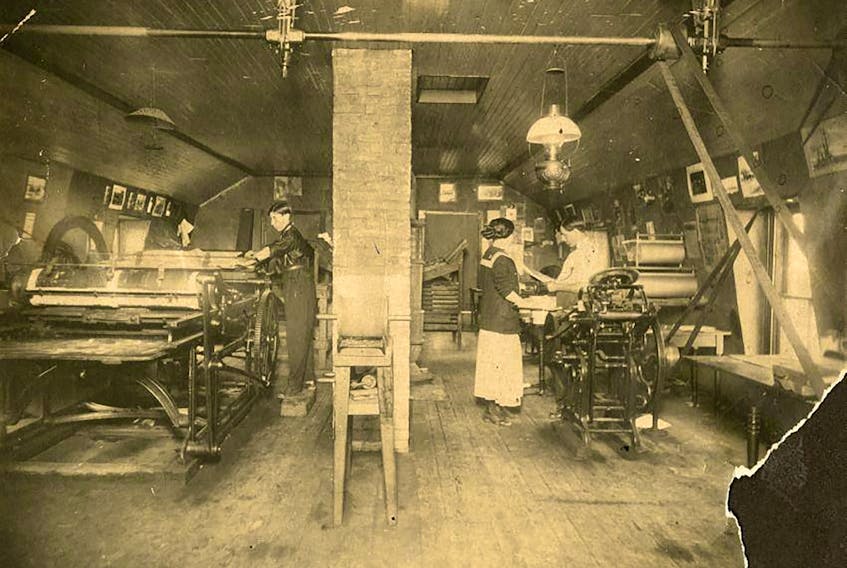News of the world and our communities seems to be so easy to find in the modern world. Social media and other modern means stream the events of the day immediately into our homes and often, into our hands.
In the pre-technological era, this feat would have seemed impossible. News took days to be printed in the local paper and months to travel abroad.
In the 1800s, the most efficient way to share news was through letters, hand-delivered and well travelled by horse or boat.
In this context, newspapers gave vital access to the news of the world and of the local community. They informed the population of political events, economic concerns and social affairs.
A local newspaper was a powerful part of the pre-industrial world.
ADVOCATE
The Cape Breton Advocate was the first newspaper published in Sydney. The first edition was released on Aug. 26, 1840. A full 55 years after the town of Sydney was established.
The Advocate was a small, eight-page paper with four columns per page. In the years of early publishing, this was no easy feat. Mass printing had to be produced by manually setting the type for each letter and creating each page. It was a painstakingly slow process that no doubt contributed to the slow and intermittent distribution of the news.
Richard Huntington published the Advocate and for the first five weeks of the paper's existence, he did all the work. He was the editor and proprietor. He did all the typesetting and printing.
Huntington was not a local and he rarely printed local news in his paper. He focused on the news from England, which was reflected in the paper’s motto: “The Queen, the Laws, and The People.”
Soon Huntington realized that the small population of Sydney, about 500 people, was insufficient to support his paper, so he began to focus on an island-wide market. He published local poetry and political diatribes that argued for Cape Breton separation from the mainland.
SPIRIT OF THE TIMES
In 1841, the Advocate was replaced by the Spirit of the Times. It was a smaller paper than the Advocate. It was printed using the same press and its editor was Richard Huntington, but the paper was owned by J.D. Kuhn.
Rumour had it that the Advocate needed to change its name because of legal issues. In those days there was not much freedom for the press, because it was likely that a publisher would be sued. The Spirit of the Times motto was “Our Adopted Country.”
Huntington soon gave up the paper to William C. MacKinnon, the grandson of the provincial secretary of Cape Breton.
MacKinnon was known for “expressing his opinions quite freely in the columns of his paper.” This expression likely was permitted based on the status of his father but it was not without its consequences.
At one point MacKinnon published an unspecified personal item in the pages of his paper. An officer in the local military took great offence to the content of the article and challenged MacKinnon to a duel. Both were lucky enough to escape unharmed.

MORE PUBLICATIONS
MacKinnon would go on to publish more Cape Breton papers — The Times and Cape Breton Spectator in North Sydney and the Commercial Herald in Sydney. None of these enjoyed a very lengthy publishing era and publications ceased by 1850.
The next newspaper was the Cape Breton News. It was first published in July 1850. At first, it was a four-column, four-page paper and only half the size of the Advocate. Later it would expand to be six columns wide. In the beginning, the News was only published twice a month, but its popularity pushed it to be printed every Saturday.
The News stopped publishing in 1871. The printing press was taken over by Molly & Jordon who used it to print the second iteration of the Cape Breton Advocate. It was a four-page, six-column sheet published every Thursday.
At about the same time the Cape Breton Times was started. It was larger than the Advocate at four pages with eight columns. It was also published every Thursday.
POLITICALLY OPPOSED
For the first time, there were two papers being published in Sydney. They were politically opposed. The Advocate supported the Conservative party, while the Times supported the Liberal party.
The Times was discontinued after the election of 1878 when the Liberals lost to the Conservatives.
The Island Reporter started in Baddeck in 1884 and then moved to Sydney a few years later. As the Island Reporter was Liberal the balance between both parties publishing partisan stories was continued.
By the spring of 1878, both papers were popular enough that they began publishing daily. They each published a small four-page, two-column paper that focused on the upcoming election.
Unfortunately, neither paper had enough circulation to justify being printed daily and lasted only two months of daily publication.
In 1879, F.G. Muggah and Joe Kavanagh tried to publish the semi-weekly Express, but that too failed when pressed into daily service. J.W.D Stearns tried again in 1892 when he published the Morning Sun. It lasted three months before it fell.
The Sun was interesting because it used a drum press to print the paper instead of the hand press. The drum press worked much faster than the traditional hand press that only printed one page at a time.
According to workers, the drum press was, “a wonderful combination of worn cogwheels, loose bolts and knotted strings that rarely turned out an issue without at least one breakdown.”
SUCCESSFUL DAILIES
A revolution in the newspaper business in Sydney occurred in 1898. The Daily Record began to be published and was a great success. Then, three years later in 1901, came the Daily Post.
All the weekly papers that were printed quickly gave way to these two papers. It was no coincidence that the success of these daily papers coincided with the establishment of the Sydney steel plant.
The population boom ensured the survival of the papers because there was the population base to support them. Eventually, these two papers would merge to create this current newspaper, which remains the final voice of the people of Cape Breton.
Vanessa Childs Rolls is a local historian who lives in Sydney. Her column appears regularly in the Cape Breton Post.








